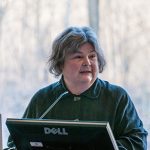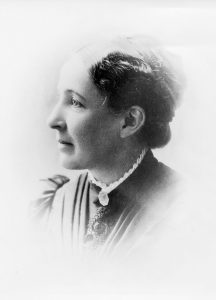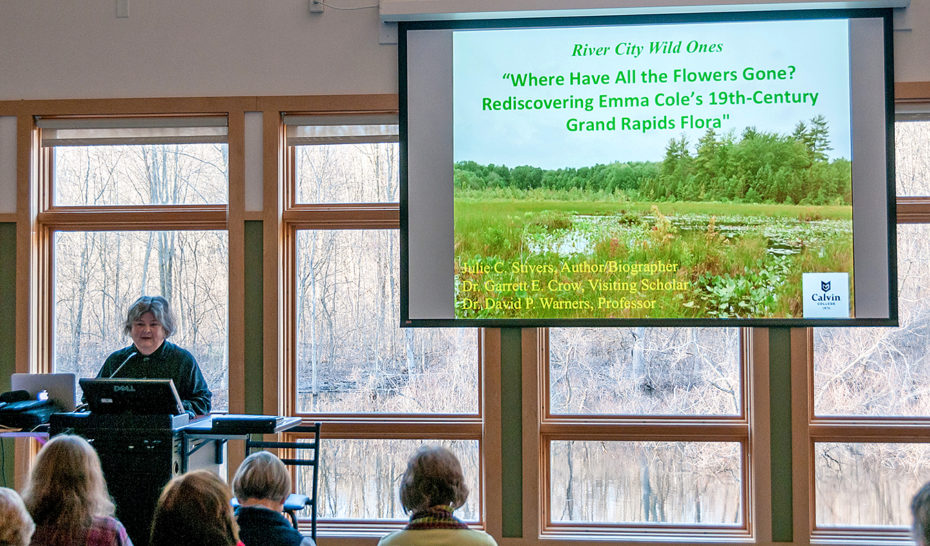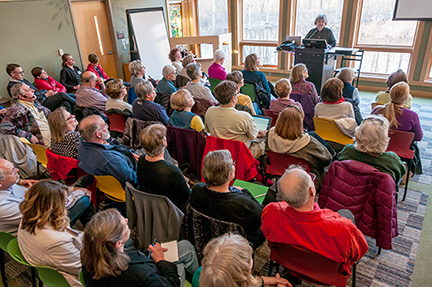March 19, 2018 RCWO Meeting Recap
Where have all the Flowers Gone?
Rediscovering Emma Cole’s 19th-Century Grand Rapids Flora
River City Wild Ones was treated to a fascinating presentation by Julie Stivers, Author, and Dr. Garrett Crow, Visiting Scholar, Calvin College.

Julie Stivers spoke first, giving a history of Emma Cole’s life. Emma was born in Ohio 1845 but later her family lived on a farm near Lowell, MI. Emma studied at Cornell University at a time when it was rare for women to attend. She never graduated but went on to become a teacher at Grand Rapids Central High School in 1882. She taught at Central for 26 years and also traveled throughout the U.S. and Europe.
Cole collected, identified, and mounted botanical specimens and donated them to the Kent Scientific Institute. In 1900 she became the institution’s Vice President. It was fun to imagine Emma going out to (then) remote areas in a horse and buggy to collect the specimens.

She published Grand Rapids Flora: A Catalogue of the Flowering Plants and Ferns Growing Without Cultivation in the Vicinity of Grand Rapids, Michigan in 1901. Her book still is the most recent comprehensive inventory of Greater Grand Rapids flora.
Emma Cole died in 1910 leaving considerable bequests to churches and organizations to further the appreciation of Grand Rapids native plants.

Dr. Garrett Crow recounted his involvement in historical research with Dr. Dave Warners, Calvin College Professor of Biology and Warners’ students. They have been going out in the field to Emma Cole’s old haunts collecting botanical specimens evaluating their status now, compared with Emma Cole?s descriptions from 1901.
Their historical research is focused on four areas: Clear Bottom Lake, Saul Lake Bog Lamberton Fen and Ken O Sha. They have found that many of the species have disappeared but some have persisted. It was heartening to hear that species Emma cataloged still exist today, even if some of the places are drained and paved. It is even more encouraging to know that students are using Emma?s work as a basis for on-going research.
 Dr. Warners is helping by planting rain gardens and native plants back into the area. He will be our speaker on April 16 talking about Reconciliation Ecology.
Dr. Warners is helping by planting rain gardens and native plants back into the area. He will be our speaker on April 16 talking about Reconciliation Ecology.
Marti McArthur, RCWO’s Vice President concluded the program by saying: “When I think of the impact Emma Cole has had on us today, even though she didn’t have a long life, her passion and knowledge for the plants of this area and the work she did in her lifetime are inspiring for us as Wild Ones. As we work to restore the ecosystems with native plants, we have no way of knowing where this will lead, and the effect it will have for the future. Hopefully, if we work to restore nature in our gardens we may have a much larger impact than we will ever know.”
FUN FACTS:
• Emma Cole identified and mounted 3,581 pages in her Herbarium.
• 1,278 specimens were waiting to be mounted when Emma died.
• A hawthorn species, Crataegus Coleae, was named for Emma Cole.


